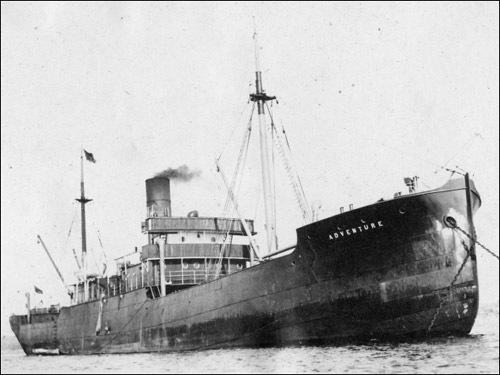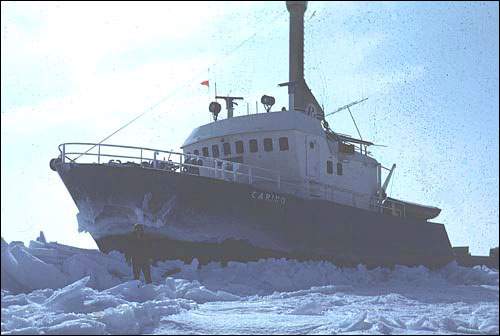The 20th Century Seal Fishery
In the years before 1914 generally rising prices helped make the Newfoundland economy comparatively buoyant. Prices for seal products modestly improved from the low point of the 1890s, and an average of 20 steamers went to the ice annually. In this improved atmosphere some merchants began to invest in larger steamers with iron and steel hulls. This change, like the original switch to steam 40 years earlier, was dictated by the increasing difficulty of finding large numbers of seals. The wooden walls, many of them small and underpowered, could not penetrate far into heavy ice and crews were having to walk long distances, sometimes in vain.
The new vessels were much more powerful. The first, the Adventure, was purchased by Harvey and Co. in 1905. Once its effectiveness had been demonstrated, other merchants followed, until there were nine in all. These ships represented heavy capital investments which owners hoped to cover by big trips and year-round employment. Bowring Brothers, for instance, built the Florizel (1018 tons) and the Stephano (2144 tons) for use as passenger and freight ships on the New York run, as well as for sealing. The experiment did not prove a great success. Though records were set - the Florizel in 1910 took the largest number of seals ever in one trip to the ice (49,069) - the overall catch did not improve significantly and insufficient revenue was generated during the balance of the year. When eager buyers lined up during the First World War, the owners were only too glad to sell.

Inter-War Seal Fishery
The inter-war seal fishery was about half the size of that which had existed before 1914. An average of only nine steamers went to the ice annually, carrying 1,500 men. The annual catch averaged 150,000 seals, whose value represented no more than one percent of total exports. Four large steel ships were included in the fleet in the late twenties, and an experiment was made in using aircraft to spot the herds, but these changes made little difference to a dismal situation. In the Second World War the steel ships disappeared, and the sealing fleet was halved yet again. Only four old wooden walls survived. In 1943 no steamers went to the ice at all, and by the end of the war the old fleet had disappeared.
Shannon Ryan has pointed out that "Life as a sealer on the eve of World War II was not much different from what it had been at the beginning of the steamer seal fishery in the 1860s." (Ryan 124) The men were divided into "watches" under the control of a master watch, who led them when on the ice, and supervised other duties. They rose early, and went out on the ice about 5 am, killing the seals with gaffs and pelting them with sharp knives. The pelts were towed to selected pans of ice and picked up by the vessel - unless it was stuck, in which case the men dragged the pelts back. They returned to the steamer about 7 or 8 pm. Then there was watch duty on board, stowing and icing the pelts, shifting coal and other duties. It was hard, exhausting and dirty work.
Reviving the Sealing Industry
The post-war years saw a revival of the sealing industry, but it was much changed. Three significant trends can be noted. First, the use of large steamers became unusual, and much more use was made of smaller motor vessels, many of them based in outports rather than St. John's. Second, there was a marked increase in the land-based seal fishery. Third, there was an unprecedentedly large participation after 1948 of Canadian and Norwegian vessels. The upshot was an end to the position of St. John's as the sealing capital of the northwest Atlantic - by the later 1950s Halifax was sending more vessels - and a withdrawal of St. John's merchants from the industry. Newfoundlanders still went sealing, but they crewed on ships for the most part-owned elsewhere. Of the 26 vessels at the ice in 1962, only two were Newfoundland registered. Of the 60,000 seals landed in Newfoundland that year, 60 percent were taken by landsmen.

The post-war sealing effort placed an undue strain upon the herds. Though the war had allowed the herd to increase to perhaps 3 million animals, it had been halved by the mid-1960s. Sealing was unsupervised and unregulated, with the result that inexperienced and ill-disciplined sealers behaved in a manner which caused concern.
It was in this context that the movement protesting the seal fishery or "hunt" emerged. The Canadian government responded by imposing regulations in 1964 and quotas in 1971. The stated purpose was to ensure the humane killing, and stabilization and expansion of the herd, while ensuring that the Atlantic region of Canada could continue to obtain income from it. This policy did not satisfy those opposed to sealing, and they persisted in their campaign. The result was the collapse of the seal market.
Although the demand for seal products has increased in recent years, the sealing industry that has survived in Newfoundland is mainly a widely dispersed landsmen operation, as it had been in the 18th century.
With the collapse of the cod fishery in the early 1990s, the twin pillars of the traditional outport economy of Newfoundland and Labrador have virtually disappeared.




